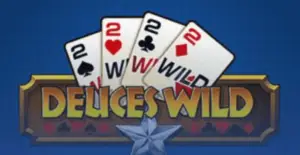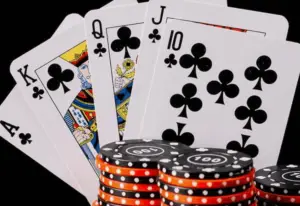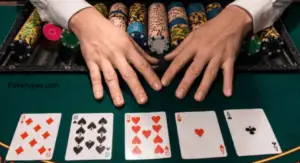The journey to becoming a successful player in Texas Hold’em begins with understanding starting hands. Starting hands are the initial two cards dealt to each player, and their significance cannot be overstated.
To become a successful poker professional, one must master the art of selecting starting hands based on table positions.
A player must know how the hand value shifts with different table positions. Beyond knowing poker hand rankings and which hands to play, a player must consider several key factors before deciding on an action.
These factors include the number of players in the hand, each player’s position and playing style, and the actions that have already taken place.
A thorough analysis of these elements can greatly enhance a player’s decision-making process and overall performance at the table.
For example, A A and K K are great hands that can be played from almost any position, while 8 4 and a 2 and 7 off suit are weak hands, and should never be played after the pre-flop round.
In this article, we will guide you on identifying the best starting hands for both novices and experienced players, equipping you with the knowledge that will enhance your playing experience. Become more knowledgeable about poker and make informed decisions that will lead to your success.
10 Best Texas Hold’em Starting Hands
Texas Hold’em starting hands can be broadly categorized into three groups: premium hands, strong hands, and speculative hands (Source).
1. Premium Hands
Premium starting hands are the strongest hands in Texas Hold’em. They have the highest potential to win big pots and are playable from any position at the table. These hands include:
Pocket Aces (AA): Considered the best starting hand, pocket aces have the highest probability of winning the pot when played correctly(Source).
Pocket Kings (KK): The second-best pocket pair, kings is also a premium hand that should be played aggressively from any position.
Pocket Queens (QQ): While still a premium hand, pocket queens can be tricky to play post-flop, especially when facing overcards.
Ace-King Suited (AKs): Also known as “Big Slick,” AKs are the best non-pair hand and are a significant favorite against most other starting hands.
With premium hands, the goal is to get as much money into the pot as possible before the flop. These hands should be played aggressively with raises, as they have a high probability of improving to the nuts on the flop.
2. Strong Hands
Strong starting hands are those that have a good chance of winning the pot but are not as powerful as premium hands. They include:
Pocket Jacks (JJ) to Pocket Tens (TT): These middle pocket pairs are strong hands, but can be difficult to play against overcards on the flop.
Ace-Queen Suited (AQs) and Ace-Jack Suited (AJs): These hands have good potential for making strong hands, but can be dominated by premium hands like AKs.
King-Queen Suited (KQs): Known as the “Royal Couple,” KQs is a strong hand that can make straights and flushes but may face difficult decisions when flopping top pair.
Strong hands should be played cautiously, often with a raise from a late position or a call from an early position. The goal is to see a flop cheaply and potentially improve to a winning hand.
3. Speculative Hands
Speculative starting hands have the potential to make strong hands but are more likely to miss the flop. They include:
Suited Connectors (e.g., 78s, JTs, QJs) – These hands can make straight and flush draws, but are vulnerable to overcards on the flop.
Small Pairs (e.g., 22-66) – While small pairs have the potential to make a set, they are often dominated by overcards and should be played cautiously.
Offsuit Broadway Cards (e.g., KQo, QJo, JTo) – These hands have good potential for making strong hands but are less likely to improve than suited versions.
Speculative hands are best played from a late position, as they allow you to see the flop cheaply and potentially make a strong hand. However, they should be folded to significant action before the flop.
Use of Starting Hands Based on Positions
The position determines the order in which players act, impacting the information available when making decisions.
Early Position:
In the early position, where players act first, it is essential to play tighter and focus on premium hands like AA, KK, QQ, and AK(Source). This approach reduces the risk of aggressive players behind you who may raise with a wider range of hands.
Middle Position:
In the middle position, players can afford to loosen their range slightly, incorporating strong hands such as AQ and JJ while still being cautious.
This position allows for a balance between aggression and caution, as players can gauge the actions of those in early positions.
Late Position:
Late position is the most advantageous, as it provides the most information about opponents’ actions. Players can play a broader range of hands, including speculative hands like suited connectors or small pairs because they can assess the strength of their opponent’s hands before acting.
Popular Starting Hand Charts
There are several popular starting hand charts used by poker players, each with its own unique features and categorizations. Some of the most widely used charts include:
The Harrington Starting Hand Chart: Developed by poker author Dan Harrington, this chart categorizes starting hands into groups labeled from 1 to 7, with 1 being the strongest and 7 being the weakest.
The Sklansky-Malmuth Starting Hand Chart: Created by poker theorists David Sklansky and Mason Malmuth, this chart groups starting hands into 13 categories based on their relative strength.
The Poker Snowie Starting Hand Chart: This chart, developed by the Poker Snowie AI, categorizes starting hands into 10 groups based on their expected value in a 6-max cash game.
The PokerStars Starting Hand Chart: PokerStars, one of the largest online poker sites, provides a starting hand chart that groups hands into 9 categories for both cash games and tournaments.
Reading and Interpreting Starting Hand Charts
Starting hand charts typically display the poker hand rankings (e.g., pocket pairs, suited connectors, suited one-gappers) along the y-axis and the positions at the poker table (e.g., early position, middle position, late position, blinds) along the x-axis.
The intersecting cells indicate the recommended action for each starting hand in a particular position. For example, in a 6-max cash game using the Sklansky-Malmuth chart:
Playing 77+ (pocket pairs of 7s or higher) and AK (suited or unsuited) in an early position is recommended.
Playing 88+ (pocket pairs of 8s or higher), 99+, ATs+, KJs+, QJs, JTs, T9s in middle position is recommended.
Playing 99+, ATs+, KJs+, QJs+, JTs+, T9s+, 87s+, 76s+, 65s+, 54s+, 43s+, 32s in late position is recommended.
It’s important to note that starting hand charts are general guidelines and should be adjusted based on factors such as stack sizes, player types, and game conditions.
They provide a solid foundation for preflop play but should not be followed blindly.
Adjusting Starting Hands According to the Opponents
In Texas Hold’em poker, the ability to adapt your starting hand selection based on the tendencies of your opponents is an essential skill.
Your winning rate can be increased if you identify and exploit weaknesses in your opponents’ games.
Importance of Player Reads
You must read your opponents in order to make an informed decision at the poker table.
When you observe the betting patterns, body language, and verbal cues of your opponents, you are able to gain valuable insight into the strength of their hands.
This information allows you to adjust your starting hand selection accordingly, playing tighter against aggressive opponents and looser against passive ones.
Identifying Opponents’ Tendencies
To identify your opponents’ tendencies, pay close attention to their actions pre-flop and post-flop. Look for patterns in their bet sizing, timing, and frequency. Are they opening too many hands from an early position?
Do they frequently call down with marginal hands? Identifying these tendencies will help you narrow their range and make better decisions when facing their actions.
Here are some examples of how to identify opponents’ tendencies:
If an opponent consistently raises from an early position with a wide range of hands, you can tighten up your starting hand selection and play fewer speculative hands against their aggression.
If a player frequently calls with weak hands, you can bluff them more often and value bet thinner when you have a strong hand.
If an opponent is prone to making large bets with a polarized range (either the nuts or complete air), you can adjust your calling ranges accordingly.
Adapting Hand Selection
Once you’ve identified your opponents’ tendencies, adjust your starting hand selection to exploit their weaknesses.
Against tight-aggressive (TAG) opponents who play a solid, fundamentally sound game, stick to playing premium hands and value hands in position.
Against loose-passive (LP) opponents who play too many hands, you can open up your starting hand range and play more speculative hands like suited connectors and small pairs. Here are some examples of how to adapt your starting hand selection:
Against a TAG opponent who rarely bluffs, you can call down with weaker-made hands and draws, knowing that they are unlikely to be bluffing.
Against an LP opponent who calls too often, you can value bet thinner with your strong hands and bluff more frequently.
If you have a positional advantage, you can play a wider range of hands and take advantage of your position to make more profitable decisions post-flop.
Remember, adapting your starting hand selection is not a one-size-fits-all approach. It’s essential to constantly observe and adjust your strategy based on the specific opponents and situations you face at the table.
Conclusion
As a player, your starting hand is one of the most significant factors affecting your success at Texas Hold’em.
The understanding of how to play each hand based on the strength of the hand and your position will enhance your decision-making and overall strategy.
As you continue to practice and refine your hand selection, you will develop a deeper insight into the dynamics of the game.
Remember, learning starting hands isn’t just about memorizing lists; it’s about adapting your strategy to different situations.
Practicing these skills will help you become a more skilled and confident poker player.































